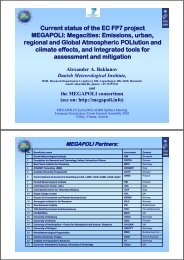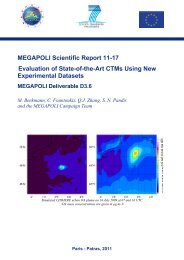D E S C R I P T I O N O F W O R K - MEGAPOLI - Dmi
D E S C R I P T I O N O F W O R K - MEGAPOLI - Dmi
D E S C R I P T I O N O F W O R K - MEGAPOLI - Dmi
Create successful ePaper yourself
Turn your PDF publications into a flip-book with our unique Google optimized e-Paper software.
<strong>MEGAPOLI</strong> 212520<br />
• the related variability in optical parameters and in hygroscopicity<br />
These data sets will be combined with routine observations from the AirParif network in a data base hosted at CNRS.<br />
This data base will then be available to the whole project, for model improvement and evaluation within this task and<br />
within WP’s 1, 2, 4 5 and 6, as well as for integrated case studies within WP7. Approximately one year after the<br />
campaign (at T + 30), the access to data base will be free.<br />
In particular, experimental data will be used to improve process models for predicting SOA formation and predicting<br />
the evolution of the aerosol size distribution in the plume. Vertical profiles of pollutant concentrations will also be used<br />
to evaluate large eddy scale (LES) simulations of urban and near-urban boundary layer (NERSC contribution, WP2).<br />
Improved process models will then be implemented into air quality models. The ability of CTM’s to correctly simulate<br />
the particulate chemical composition for a variety of situations (including pollution episodes with low dispersion and/or<br />
high photochemical activity) will be thoroughly evaluated with the available data sets. As a result of this exercise, these<br />
models can then be used with more confidence for emission reduction and mitigation option scenarios.<br />
Deliverables<br />
D3.1 Database of chemical composition, size distribution and optical parameters of urban and suburban PM and its<br />
temporal variability (hourly to seasonal) (month 24)<br />
D3.2 Source appointment of major urban aerosol components (OC, BC, inorganic ions), including primary and<br />
secondary PM sources (month 27)<br />
D3.3 Effective emission factors for OC and BC for urban type emissions (month 24)<br />
D3.4 Database of the impact of megacity emissions on regional scale PM levels (month 24)<br />
D3.5 Evaluation of links between secondary VOCs and secondary organic aerosols of anthropogenic and biogenic<br />
origin (month 30)<br />
D3.6 Evaluation of state of the art CTMs using new experimental data sets (month 30)<br />
D3.7 Implementation of improved parameterizations of BC, OC emissions and secondary PM formation in CTMs<br />
(month 30)<br />
38




